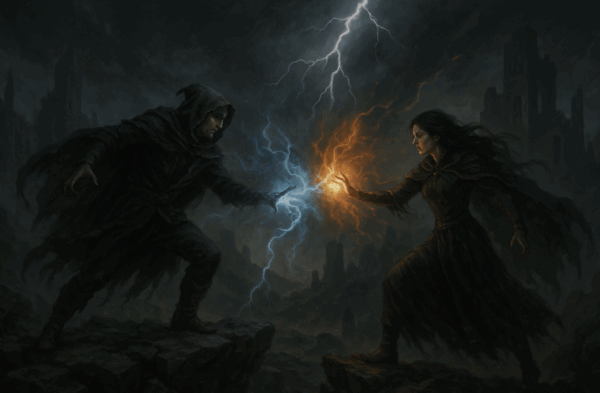What makes a story good? Is it the heart-pounding suspense of a mystery novel, the boundless imagination of a fantasy world, or the emotional depth of a love story? A great story stays with us long after we’ve turned the last page. It makes us feel, wonder, and, most importantly, believe in the journey of its characters. When writing a story, it’s these elements that create a lasting impact on readers.
From classic literature to bestselling novels, all compelling stories share essential ingredients: well-developed characters, an engaging plot, and a vivid setting. But how do these elements shift when writing mystery, fantasy, or romance? This article breaks down what makes a good story stand out—whether you’re crafting a thrilling whodunit, an epic adventure, or a heartwarming love story.
The Foundation of a Good Story
A compelling story doesn’t just happen—it’s built with intentional choices that keep readers engaged. When writing a story, what makes a good short story or novel is the careful use of key elements that draw readers in and hold their attention.
1. A Good Beginning
A good beginning is essential to hooking the reader and drawing them into the story. It should introduce the main character, setting, and conflict, setting the tone for the rest of the narrative. A compelling start raises questions in the reader’s mind, making them eager to find out what happens next.
One effective technique is to start in medias res, or amid the action. This approach creates a sense of urgency and immediacy, pulling the reader directly into the story without a lengthy introduction or backstory. For instance, opening with a dramatic event or a pivotal moment can instantly grab attention.
Introducing the main character in a way that makes the reader care about them is crucial. Showcasing their thoughts, feelings, and motivations helps to build a connection. Relatable and sympathetic characters are more likely to engage readers from the outset.
Finally, the beginning should set the tone for the entire story. Using language and imagery to create a specific mood or atmosphere, and hinting at key themes and ideas, helps to establish the narrative’s direction and keeps readers intrigued.
2. Compelling Characters
Readers connect with characters who feel real, flawed, complex, and driven by goals. Understanding how a character reacts to events in a story is crucial for creating emotional engagement and narrative depth. Whether it’s a detective solving a case, a wizard learning magic, or a lover navigating heartbreak, characters should have depth. Their choices, growth, and relationships with other characters shape the story’s emotional core.
3. An Engaging Plot
A plot should move the story forward with purpose. A story that lacks direction will fall flat, losing the reader’s interest. Whether it’s a mystery with unexpected twists, a fantasy quest with rising action, or a romance with emotional stakes, every scene should serve the overall narrative.
4. A Vivid Setting
Setting isn’t just a backdrop—it shapes the characters and events. Fantasy and science fiction stories transport readers to new worlds, while mysteries often rely on eerie atmospheres or urban landscapes. The more immersive the setting, the stronger the reader’s connection to the story.
5. Narrative Voice & Writing Style
The way a story is told matters. First-person narration brings readers inside a character’s mind, while third-person gives a broader view of the world. Writing style, from lyrical prose to snappy dialogue, sets the tone and keeps readers engaged.
6. Universal Themes
Great stories explore themes that resonate with readers—love, identity, justice, adventure. Whether it’s the coming-of-age lessons in the Harry Potter series or the philosophical questions in science fiction, themes add depth and meaning to a narrative.
7. Strong Narrative Structure
A strong narrative structure is the backbone of a compelling story. It refers to how the story is organized and presented, encompassing the plot, characters, setting, and themes. A well-structured narrative has a clear beginning, middle, and end, making it easy for readers to follow and stay engaged.
One popular narrative structure is the three-act structure, which includes a setup, confrontation, and resolution. This format is effective in both short stories and novels, creating a natural flow of tension and resolution. The setup introduces the main elements, the confrontation builds conflict and challenges, and the resolution ties up loose ends.
Pacing and tension are critical components of a strong narrative structure. Pacing refers to the speed at which the story unfolds, while tension is the sense of conflict or suspense that propels the story forward. Balancing moments of high tension with periods of release and resolution keeps readers on the edge of their seats.
A clear narrative voice is also essential. Whether it’s a first-person perspective that brings readers inside the protagonist’s mind or a third-person view that offers a broader scope, the narrative voice should be consistent and engaging, guiding readers through the story.
What Makes a Good Mystery Story?
Mystery stories keep readers hooked by posing a question: Who did it? Why did it happen? How will the protagonist uncover the truth? What makes a good mystery story is its ability to maintain suspense, intrigue, and clever storytelling that keeps readers on the edge of their seats.
1. The Inciting Incident
Every mystery starts with a disruption—a crime, a disappearance, or a hidden secret. This event propels the protagonist into action, compelling them to seek answers.
2. Rising Action & Clues
A mystery unfolds through layers of tension. Clues are scattered throughout, leading readers closer to the truth while keeping them guessing. The best mysteries challenge readers to piece things together.
3. A Protagonist Who Overcomes Challenges
A detective, journalist, or amateur sleuth must navigate obstacles—misleading clues, reluctant witnesses, or personal dilemmas—to solve the mystery. Their determination and intellect keep the story compelling.
4. Foreshadowing & Red Herrings
Great mystery writers, like Agatha Christie, masterfully mislead readers while planting subtle hints. Foreshadowing builds suspense, while red herrings keep readers from solving the puzzle too soon.
5. A Satisfying Resolution
The final reveal should feel earned, not forced. A great mystery ties up loose ends while delivering an unexpected, yet logical, conclusion.
Great Example: Sherlock Holmes stories by Arthur Conan Doyle.
Your Publishing Journey Awaits – Start NowWhat Makes a Good Fantasy Story?
Fantasy stories transport readers to extraordinary worlds, blending imagination with universal human struggles. What makes a good fantasy story is how it combines a richly built world with compelling characters and high stakes, whether it’s high fantasy (Lord of the Rings) or urban fantasy (Harry Potter series). A strong fantasy story follows these principles:
1. An Immersive World
World-building is crucial. Whether it’s a medieval kingdom or a futuristic society, the setting should feel real, with its own rules, history, and cultures.
2. A Magic System & Its Rules
If magic exists, it should have limitations and consequences. The Harry Potter series is a great example of a structured magic system that feels believable within its world.
3. Characters Who React to the World
A great fantasy story isn’t just about world-building—it’s about how characters navigate that world. Their challenges, conflicts, and relationships drive the story forward.
4. Conflict & High Stakes
Fantasy thrives on epic conflicts—good vs. evil, rebellion against tyranny, personal redemption. Stakes should feel meaningful, making readers invested in the protagonist’s journey.
5. Universal Themes & Symbolism
Like all great stories, fantasy explores deeper themes—power, destiny, love, and sacrifice. A compelling fantasy novel makes readers reflect on real-world issues through a magical lens.
Great Example: The Harry Potter Series by J.K. Rowling.
What Makes a Good Love Story?
Romance stories resonate because they tap into the human experience of love, heartbreak, and personal growth. What makes a good love story is its ability to explore these emotions deeply, creating characters whose journeys feel real and relatable. But what separates a memorable love story from a forgettable one?
1. Characters with Depth
A love story is only as strong as its characters. A romantic lead should have flaws, dreams, and agency—someone readers want to root for.
2. Emotional Conflict & Growth
Great romance isn’t just about falling in love—it’s about overcoming obstacles. Whether it’s external conflict (family, distance) or internal struggles (fear, self-doubt), characters must grow throughout the story.
3. Body Language & Dialogue
Romance isn’t just about grand declarations—it’s in the small moments. Subtle body language, tension-filled conversations, and unspoken emotions make relationships feel authentic.
4. Balancing Love & Plot
Romance should enhance the story, not overshadow it. The best love stories weave romance into the larger narrative rather than making it the sole focus.
5. A Satisfying Resolution
Whether the ending is happy, bittersweet, or open-ended, it should feel meaningful. A satisfying resolution leaves readers emotionally fulfilled.
Great Example: The Fault in Our Stars by John Green.
How to Make Your Story Stand Out
Even with strong characters and a solid plot, writing a story requires a unique touch to truly shine.
- Avoid Clichés: Fresh perspectives keep stories original.
- Pacing Matters: Short stories and novels require different rhythms.
- Supporting Characters Shape the Protagonist: Side characters add depth and contrast.
- Strong Narrative Voice: A distinctive voice makes a story memorable.
Avoiding Common Pitfalls
Creating a compelling story involves steering clear of common pitfalls that can detract from the narrative. One major pitfall is the use of clichés and overused plot devices. These familiar elements can make a story feel predictable and unoriginal, causing readers to lose interest. When writing a story, it’s essential to avoid these traps to keep the narrative fresh and engaging.
Poor pacing and tension are other common issues. A story that moves too slowly can become boring, while one that rushes can be overwhelming. Striking the right balance ensures that the narrative maintains a steady rhythm, keeping readers engaged without feeling rushed or dragged out.
Weak or unengaging characters are another frequent problem. Characters should be well-developed, with distinct thoughts, feelings, and motivations. They need to be active participants in the story, driving the plot forward rather than merely observing events. Relatable and dynamic characters are key to maintaining reader interest.
By avoiding these pitfalls—clichés, poor pacing, and weak characters—what makes a good short story becomes clearer, making it much easier to write a story that captivates and holds the reader’s attention from beginning to end.
Final Thoughts: Bringing Your Story to Life
A truly great story isn’t just read—it’s felt. Whether you’re crafting a mystery that keeps readers on edge, a fantasy that transports them to another world, or a romance that tugs at the heart, what makes a story good is the passion behind the writing. The most unforgettable stories come from deep, authentic emotions, unique perspectives, and a willingness to explore the unknown.
FAQs – What Makes a Good Story?
Q1: What makes a story so powerful?
What makes a good story powerful is its ability to leave a lasting emotional or intellectual impact, drawing readers into its world and making them feel deeply connected. It resonates because of its relatable characters, emotional depth, and universal themes like love, loss, justice, or redemption. More than just entertainment, a powerful story provokes thought and reflection, encouraging readers to see the world differently. For example, To Kill a Mockingbird by Harper Lee remains influential due to its exploration of morality and justice.
Q2: How do you define a good story?
A good story captures the reader’s attention, keeps them engaged, and leaves a lasting impression. It has a clear structure with a well-defined beginning, middle, and end, allowing the plot to unfold naturally. Strong character development is key—protagonists should grow and evolve through their experiences. Conflict plays a crucial role in sustaining interest, and the resolution should be satisfying, whether it’s happy, bittersweet, or open-ended. Ultimately, a good story lingers in the reader’s mind long after they’ve finished it.
Q3: What makes writing good?
Good writing is not just about flawless grammar; it’s about effectively conveying their ideas and emotions. Clarity ensures that sentences flow naturally, while engagement keeps the reader hooked from the first line. Authenticity makes a piece stand out—writers with a unique voice bring something fresh to the table. A strong story also relies on well-chosen words, vivid descriptions, and powerful verbs that create impact. Instead of simply telling the story, great writing allows the reader to experience it.
Q4: What makes a piece of writing memorable?
Memorable writing stays with the reader, making an impact long after the last page. A unique perspective or fresh take on a familiar theme can elevate a story beyond the ordinary. Emotion plays a major role—stories that make readers laugh, cry, or reflect deeply are often the most unforgettable. Iconic characters, such as Sherlock Holmes or Katniss Everdeen, leave lasting impressions because they feel real and relatable. Lastly, a powerful ending—whether shocking, satisfying, or thought-provoking—cements a story in the reader’s memory.
Q5: How do you build a good story?
A strong story starts with a solid foundation. When thinking about what makes a good story, consider these key steps:
- Start with an Idea – What message or emotion do you want to convey?
- Develop Your Characters – Give them goals, flaws, and motivations that drive the plot.
- Create Conflict – Every good story thrives on challenges and obstacles.
- Plan the Structure – A well-paced beginning, rising action, climax, and resolution ensure a compelling narrative.
- Write and Revise – The first draft is just the beginning; great storytelling comes through refining and editing.
Layering depth into each element—characters, world, and themes—helps create a truly immersive experience for readers.
Q6: What are the 5 most important elements of a short story?
Short stories rely on precision, making every word count. The five most crucial elements include:
- A Single Focus – Unlike novels, short stories revolve around one key theme or event.
- Strong Characters – Despite the short length, the protagonist should feel fully developed.
- Concise, Engaging Plot – Every sentence should contribute to the story’s momentum.
- Atmosphere & Setting – Even with limited space, vivid descriptions can enhance immersion.
- A Powerful Ending – Whether it’s a twist, an emotional moment, or an open-ended question, the ending should leave an impact.
For instance, Shirley Jackson’s The Lottery delivers a chilling and unforgettable message in just a few pages.
Q7: What makes a book successful?
A book’s success is not just about sales—it’s about impact, longevity, and how deeply it connects with readers. A unique and engaging storyline keeps readers invested, while compelling characters make them care about the journey. Word-of-mouth appeal is powerful; books that spark discussion and emotional or intellectual resonance tend to thrive. A successful book doesn’t just entertain—it leaves readers changed in some way.
Q8: What makes a great story idea?
A great story idea isn’t just interesting—it has depth, emotional weight, and built-in conflict. One way to generate compelling ideas is by asking a “What If” question. For example, what if people’s dreams became reality? (Inception). A fresh perspective on familiar themes can also make a story stand out. Most importantly, strong story ideas naturally create tension and challenges, ensuring an engaging plot.For example, The Hunger Games takes a familiar dystopian setting but infuses it with personal stakes, survival, and moral dilemmas, making it both gripping and thought-provoking.







